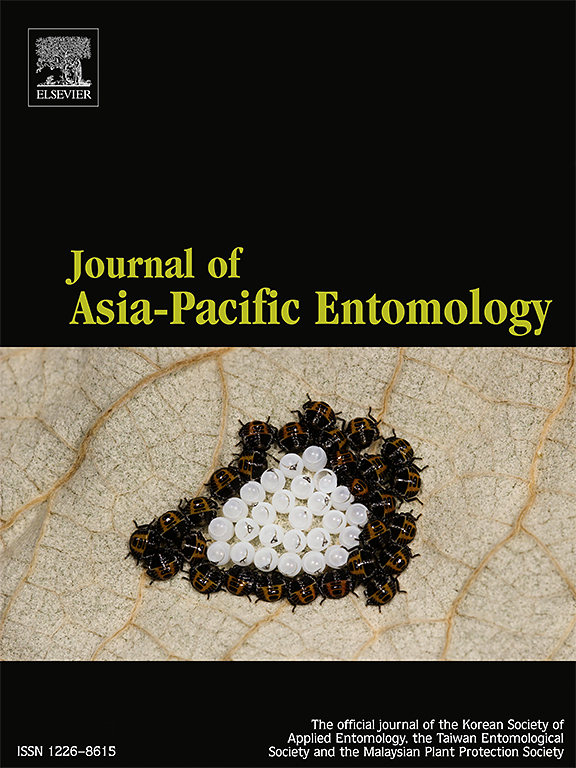Sublethal concentrations of anthelmintic drugs (albendazole and levanide) induce insecticidal effects and midgut ultrastructural changes in Spodoptera frugiperda (Lepidoptera: Noctuidae)
IF 1.3
3区 农林科学
Q3 ENTOMOLOGY
引用次数: 0
Abstract
The fall armyworm (FAW), Spodoptera frugiperda (Lepidoptera: Noctuidae) is a globally serious pest of maize and various cultivated plants. Rapid resistance development in certain pest populations underscores the urgent need for new, effective insecticides. The present study aimed to investigate the insecticidal potential of two anthelmintic drugs (albendazole and levanide) as alternative safer tools against this destructive lepidopteran pest. The toxicity and survival response of FAW larvae to both drugs were evaluated. Subsequently, the histopathological and ultrastructural effects of the drugs’ sublethal concentration (LC25) on the midgut of third-instar larvae after 48 h of treatment were studied. The larval survival percentage of control group was 100 %, whereas the LC50/48 h of albendazole and levanide treatment caused the survival percentage to drop to 51 % and 45 %, respectively. Furthermore, the sublethal concentration (LC25) of the drugs reduced the survival of larvae by dramatically disrupting the S. frugiperda midgut’s ultrastructure and hindering insect development. Interestingly, both drugs at LC25/48 h damaged the peritrophic matrix releasing cell apical protrusions and apocrine secretions into the midgut lumen and breaking down microtubules leading to cellular hypertrophy. The study also found deterioration in mitochondrial structure. The most noticeable changes were an irregular nuclear envelope and nucleus with condensed chromatin and increased autophagy and apoptosis. Comparatively, the difference in cytotoxicity between drugs depended on their mode of action. The present findings confirm that both anthelmintic drugs even at sublethal concentrations have significant insecticidal potentials and might be an alternative, safer environmental tool in managing FAW larvae.

亚致死浓度的驱虫药物(阿苯达唑和左旋胺)可诱导杀虫效果和夜蛾中肠超微结构变化。
秋粘虫(FAW)是危害玉米和各种栽培植物的全球性严重害虫。某些害虫种群抗药性的快速发展凸显了对新型有效杀虫剂的迫切需求。本研究旨在探讨两种驱虫药物(阿苯达唑和levvanide)对这种具有破坏性的鳞翅目害虫的杀虫潜力。对两种药物对FAW幼虫的毒性和生存反应进行了评价。随后,研究了药物亚致死浓度(LC25)对三龄幼虫处理48 h后中肠组织病理学和超微结构的影响。对照组的幼虫存活率为100%,而阿苯达唑和左旋烷处理的LC50/48 h使幼虫存活率分别降至51%和45%。此外,亚致死浓度(LC25)显著破坏了frugiperda中肠的超微结构,阻碍了昆虫的发育,从而降低了幼虫的存活率。有趣的是,两种药物在LC25/48 h时都破坏了营养周围基质,释放细胞顶端突起和大汗液分泌物进入中肠管,并破坏微管导致细胞肥大。该研究还发现线粒体结构恶化。最明显的变化是核膜不规则,细胞核染色质浓缩,自噬和凋亡增加。相比之下,药物之间的细胞毒性差异取决于它们的作用方式。目前的研究结果证实,这两种驱虫药物即使在亚致死浓度下也具有显著的杀虫潜力,可能是一种替代的、更安全的管理FAW幼虫的环境工具。
本文章由计算机程序翻译,如有差异,请以英文原文为准。
求助全文
约1分钟内获得全文
求助全文
来源期刊

Journal of Asia-pacific Entomology
Agricultural and Biological Sciences-Insect Science
CiteScore
2.70
自引率
6.70%
发文量
152
审稿时长
69 days
期刊介绍:
The journal publishes original research papers, review articles and short communications in the basic and applied area concerning insects, mites or other arthropods and nematodes of economic importance in agriculture, forestry, industry, human and animal health, and natural resource and environment management, and is the official journal of the Korean Society of Applied Entomology and the Taiwan Entomological Society.
 求助内容:
求助内容: 应助结果提醒方式:
应助结果提醒方式:


